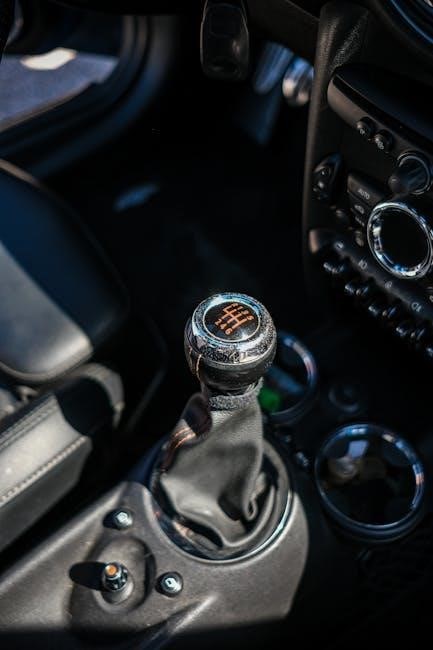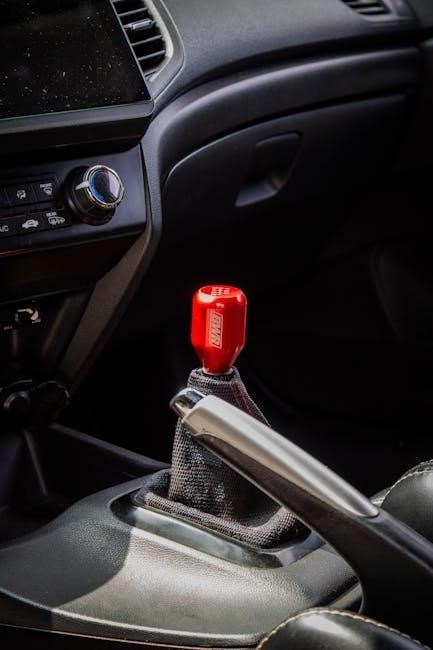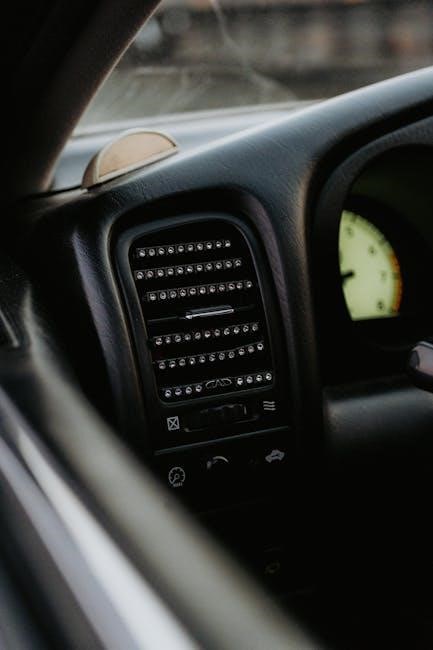
Manual shift linkage is a system connecting the gear selector to transmission parts, enabling smooth gear changes, with various components working together, including shift rails and shift forks, in a vehicle transmission.
Definition and Purpose
The manual shift linkage is defined as a system of components that connects the gear selector to the transmission parts, enabling the driver to shift gears smoothly and accurately. The purpose of the manual shift linkage is to facilitate the transfer of power from the engine to the wheels, allowing the vehicle to move at various speeds. This system is essential for the proper functioning of a manual transmission vehicle, as it enables the driver to control the gear changes and adjust the speed of the vehicle. The manual shift linkage plays a crucial role in the overall performance and efficiency of the vehicle, and its proper functioning is essential for safe and smooth driving. The definition and purpose of the manual shift linkage are closely related to its components and functioning, which work together to achieve this goal. The system is designed to provide a smooth and precise gear shifting experience.

Components of Manual Transmission Shifter
Key components include shift lever, shift rails, and synchronizers, working together seamlessly always.
Shift Lever and Shift Rails
The shift lever is a crucial component of the manual transmission shifter, connecting the driver to the transmission. It is typically mounted on the center console or steering column, allowing the driver to easily select gears. The shift rails, on the other hand, are responsible for connecting the shift lever to the shift forks, which engage and disengage the gears. The shift rails work in conjunction with the shift lever to provide a smooth and precise shifting experience. By understanding the relationship between the shift lever and shift rails, drivers can better appreciate the complexity and sophistication of the manual transmission system. The shift lever and shift rails work together to enable the driver to control the vehicle’s speed and power. This system is critical to the overall performance and efficiency of the vehicle.

Internal Shift Linkage
Internal shift linkage connects the shift lever to the fork, enabling gear selection, with shift rails moving shift forks attached to synchronizers, controlling gear changes precisely always.
Shift Forks and Synchronizers
Shift forks and synchronizers are crucial components of the manual shift linkage system, working together to facilitate smooth gear changes. The shift forks are responsible for engaging and disengaging the gears, while the synchronizers ensure that the gears are properly aligned before engagement. Each synchronizer is capable of changing two-speed gears, allowing for seamless transitions between gears. The shift forks are typically attached to the shift rails, which are connected to the shift lever, enabling the driver to select the desired gear. The synchronizers play a critical role in preventing gear grinding and ensuring that the gears are properly engaged, making them an essential part of the manual shift linkage system. The proper functioning of shift forks and synchronizers is essential for smooth and accurate gear changes, and any issues with these components can lead to transmission problems.

Adjusting Manual Transmission Shift Linkages
Manual transmission shift linkages require adjustment for proper functioning, ensuring smooth gear changes and preventing transmission issues, with safety precautions taken during the adjustment process always.
Safety Precautions
When adjusting manual transmission shift linkages, it is essential to take safety precautions to avoid accidents and injuries. The vehicle should be placed on a level surface, and the engine should be turned off. The parking brake should be engaged to prevent the vehicle from moving. Additionally, the transmission should be in neutral gear to prevent any accidental gear changes. It is also recommended to consult the vehicle’s manual and follow the manufacturer’s instructions for adjusting the shift linkage. By taking these safety precautions, one can ensure a safe and successful adjustment process. The importance of safety cannot be overstated, as it can help prevent damage to the vehicle and injury to the person performing the adjustment. Proper safety measures can also help prevent costly repairs and ensure the vehicle runs smoothly and efficiently. Always prioritize safety when working with vehicles.

Troubleshooting Shift Linkage Problems
Identify issues with shifting, such as difficulty or grinding, to determine the problem with the manual shift linkage system and its components.
Common Issues and Solutions
Common issues with manual shift linkage include worn or damaged components, misalignment, and improper adjustment. These problems can cause difficulty shifting gears, grinding or clunking noises, and even complete loss of gear engagement. To solve these issues, it is essential to identify the root cause and take corrective action, such as replacing worn components, adjusting the shift linkage, or realigning the system. Regular maintenance and inspection can help prevent these problems from occurring, ensuring smooth and reliable gear shifting. By addressing common issues and implementing solutions, drivers can enjoy improved performance, reduced wear and tear, and enhanced overall driving experience. Proper diagnosis and repair of manual shift linkage issues require a good understanding of the system and its components, as well as the necessary tools and expertise to perform the repairs correctly and efficiently.
Manual shift linkage plays a crucial role in vehicle transmission, requiring proper maintenance and adjustment for smooth operation, with regular checks and repairs ensuring optimal performance and longevity always.
Importance of Manual Shift Linkage
The manual shift linkage is a critical component of a vehicle’s transmission system, playing a vital role in ensuring smooth and efficient gear changes. Properly functioning manual shift linkage enables drivers to control the vehicle’s speed and power, which is essential for safe and effective driving. The importance of manual shift linkage lies in its ability to provide a direct connection between the driver and the transmission, allowing for precise control over gear shifts. This, in turn, enables drivers to optimize fuel efficiency, performance, and overall driving experience. Furthermore, a well-maintained manual shift linkage helps to prevent wear and tear on other transmission components, reducing the risk of costly repairs and prolonging the lifespan of the vehicle’s transmission system. Regular maintenance and adjustment of the manual shift linkage are essential to ensure optimal performance and longevity.